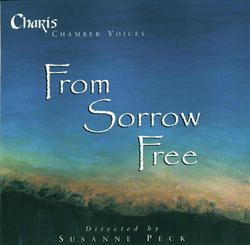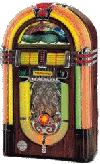The
songs of America may be as diverse as the nation itself,
but they share a distinctive strength of spirit that unites them. From the
fervor of seventeenth-century colonial New England hymns and the mournful
ballads of the Appalachian Mountains, to the hardened humor in a Depression-era
tune and the rhythmic chant of work songs from the rivers, American melodies
transported their singers out of the physical, often painful, world they
inhabited by placing their hearts in a song. This emotional character endures
in the works of contemporary American composers who continue to draw on the
American experience for inspiration, on occasion "quoting" the people's music
as a way to convey a nation's spirit. It is the strength of this American voice
and its power to transcend the moment to touch the timelessness of the soul
that we celebrate in From Sorrow Free.
The
innovative Charles Ives (1874-1954) sought to create a uniquely American sound,
and incorporated church, folk, and popular tunes in many of his polytonal
works. He realized early on that he would be unable to earn a living from
music, and so chose to become a businessman, composing primarily for his own
pleasure. It wasn't until well after his retirement that his work became known,
eventually earning him a Pulitzer Prize. In 1918, seeking to put his musical
affairs in order following a severe heart attack, Ives privately published a
collection of songs that included the meditative Serenity.
This uncharacteristically tonal work demonstrates the rhythmic experimentation
Ives loved, with keyboard and voice parts moving in complementary but
independent lines.
A
distinctively American singing style was born in the late 1700s with the
invention of a new system of music notation called "shape-note." Ministers in colonial New England needed ways to teach hymns to their
musically illiterate congregants, and so singing schools appeared and
flourished. Many used practice songbooks with musical notes of different shapes
that corresponded to certain notes in the fa-so-la
scale. The shape-note method soon dropped from favor in the North but became
immensely popular in the rural South and West, where shape-note sings became
community social and spiritual events and remain so to the present day. The Traveller comes from perhaps
the most popular shape-note songbook of the nineteenth century, The Southern Harmony and Musical Companion (1835) compiled
by William "Singing Bill" Walker, who claimed to have sold 600,000 copies. The
story goes that Walker and his brother-in-law, B. F. White, collaborated on the collection, but
White was not credited when the book appeared in print and the two men never
spoke to one another again. Walker's fame became such that he would follow
his signature with the initials "A.S.H" for "Author of Southern
Harmony." But White went on
to collaborate on the tune book that would become synonymous with shape note
singing ever after, The Sacred Harp,
which has been in continuous print for over 150 years and includes the joyous All is Well. Such tunes were customarily written for three
or four voice parts, with the melody in the tenor line. When sung, some
sopranos and tenors would double the other's part in their own register,
creating a richly-layered five-or-six part texture from the music's simple harmony.
A
common theme in early New England sacred music was the inevitability of death, as
illustrated in the somber Brevity and Decay. Abraham Wood (1752-1804), a native of the
Massachusetts Bay Colony and drummer during the Revolutionary War, was a prominent
composer whose best work is noted for its eloquence and nobility. His Brevity uses simple, expressive harmony with just a brief
dissonance on the word "evening" for dramatic effect. Stephen Jenks (1772-1856)
was the compiler of ten collections of psalmody and was the major nineteenth
century composer of "fuging" tunes, of which Decay is an example. The American fuging
tune (the spelling favored at the time to distinguish it from the classical
"fugue") features a section with a musical theme sung in overlapping succession
by each voice part, and then repeated to increase the rhythmic vigor of the
piece. Jenks also composed Sorrow's Tear,
thought to be the earliest American setting of the popular Thomas Moore poem.
The lyrics for Hatfield were also popular with
several colonial composers, including William Billings. Joel Cohen, music director of the Boston Camerata, found the lovely, interwoven arrangement on this
recording in a Newburyport, Massachusetts library.
William
Billings (1746-1800), born in Boston, was a tanner by trade but his passion for
music led him to overcome physical deformity and lack of formal training to
become America's first professional musician. Billings created a new style of music indigenous
to the colonies, employing vigorous, dance-like rhythms that he claimed were
"more than twenty times as powerful as the old tunes." His composition Africa appeared in 1770 in The
New-England Psalm-Singer, the first published collection of wholly
American music and the first American songbook by only one composer. Billings' energetic style was well suited to the
shape-note followers, and many of his songs appear in both The Southern
Harmony and The Sacred Harp. Billings may also have been the first -- though
certainly not the last -- professional American musician to die a pauper. He lies
today in an unmarked grave in Boston Common.
The year 2000 marked the centennial of the
birth of Aaron Copland (1900-1990). Born in Brooklyn but trained largely in Europe, Copland explored musical styles ranging
from neo-classicism to symphonic jazz to 12-tone abstraction. But it was the
popular work he composed around the 1940s, which centered on American heroes
and folk melodies, that would earn him the reputation
of dean of American music. In 1950, he published arrangements for five Old American Songs, including Long Time
Ago, an anonymous
minstrel tune first issued in 1837. The minstrel show, in which white (and even some black)
performers appeared in blackface make-up, was nineteenth-century America's
favorite stage entertainment, and became a leading vehicle for composers of
popular songs, such as Stephen Foster.
In
this recording, Charis
is privileged to enjoy the talents of Julie Dolphin as both singer and
composer. Ms. Dolphin, who joined the renowned Waverly Consort in 2000, has
been performing and composing in various idioms for many years. Here she
contributes two arrangements of traditional folk songs and two original
compositions set to contemporary poetry. I Am A
Poor Wayfaring Stranger is an example of
the "white spiritual" known as the "religious ballad" that grew from revivalist
meetings, where converts sought to witness their faith in narrative song. In
this passionate arrangement, the lyrics carry great weight and dignity. Hallelujah, I'm a Bum by Harry "Mac" McClintock (1882-1957)
appeared in 1909 in the Little Red Songbook published
by the Industrial Workers of the World (known as the "Wobblies"),
of which McClintock was a member. Ms. Dolphin's lively syncopation transforms
the tune into a rhythmic, jazz-like dance. The great New England poet Robert Frost was known for using
natural events to illustrate philosophical reflections. Ms. Dolphin has chosen October, from his first published collection of poems, to
offer a meditation on mortality that climaxes with an impassioned plea for a
slower passing of the day. Her final offering, Adieu,
set to a poem by Irish-born Seamus DeBrun, uses
shifts in meter, rhythm and dynamics to echo the pain of parting.
Folk
music offers today's composers a rich and abundant source of material. Composer and conductor Mark Wilberg's
lovely and lyrical I'm Goin'
Away is a variation on the Appalachian folk song, Who's Gonna
Shoe Your Pretty Little Feet? It's theme of separation and
faithfulness lies at the root of much southern folk music. Dr. James Erb, founder of the Richmond Symphony Chorus, has created
an arrangement of Shenandoah that has become almost
as popular as the original tune itself. Like most well-known folk songs, Shenandoah has been handed down in several versions
(including one about the daughter of an Indian chieftain). Most music
historians, however, categorize it as a sea chanty,
probably sung by American and Canadian voyageurs boating
the Missouri
River as
they recalled the Shenandoah Valley of Virginia. Composer, conductor and lecturer Alice Parker
has been active for almost six decades, and is perhaps best known for her
twenty-year collaboration with the late choral conducting great, Robert Shaw.
Her chilling Johnny, I Hardly Knew Ye is
actually an arrangement of an Irish anti-war folk song that dates back to the
Crimean Wars, but is included here because it is easily recognized as the
forerunner of the famous, war-glorifying American song, When Johnny
Comes Marching Home. The American Johnny was
published in 1863 by Louis Lambert, a pseudonym for Patrick Sarsfield
Gilmore, bandmaster for the Union Army during the Civil War and founder of the
foremost professional band in the United States in the late 1800s. It comes as no
surprise that he was also a native of Ireland.
Spring Cycle by contemporary American composer James Harold Carr is a
work very close to our heart, and not simply because is the first original
composition commissioned for Charis. As Carr explains, "This work is a collaboration between myself, the poet Lynette Peck, and
the conductor Susanne Peck. I have
dedicated the setting to their father, the late Reverend George Peck, who
performed my wedding. Each of us three
has contributed in our own fashion to this three-part meditation on the arrival
of spring. Spring Cycle
is a setting of three poems by Lynette Peck. In each, a different aspect of the poet's
relationship to spring is revealed as the seasons transform. In each poem,
spring can be seen as a developing metaphor for faith and rebirth. I chose to
modify my harmonic language to reflect this progression of inner states."
Pamela Parker




 for sound clips from arbitrary portions of the track (explained below).
for sound clips from arbitrary portions of the track (explained below).
 for streaming Windows Media files. They are optimized for a 32K bps connection, and should play using the
Windows Media Player or the
Real One Player (if they don't play for you, try these links to upgrade your player).
for streaming Windows Media files. They are optimized for a 32K bps connection, and should play using the
Windows Media Player or the
Real One Player (if they don't play for you, try these links to upgrade your player).


![[Click here to see full-size photo!]](group2000-300.jpg)